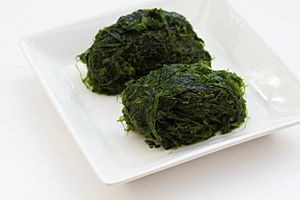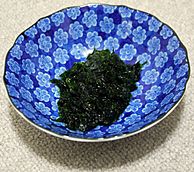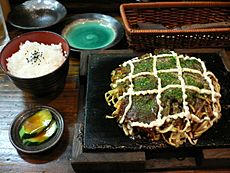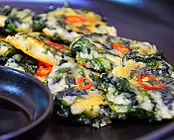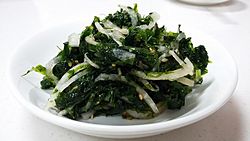Green laver facts for kids
Green laver is a type of edible green seaweed. It's known by different names around the world. In Japan, it's called aonori (アオノリ). In China, people call it sea cabbage (海白菜). And in Korea, it's known as parae (파래). This seaweed includes types from the Monostroma and Ulva families.
Green laver is grown in special bay areas. You can find it in places like Ise Bay in Japan. It's also farmed in Korea and Taiwan. This seaweed is packed with good stuff for your body. It has important minerals like calcium and magnesium. It also contains many vitamins and amino acids. Sometimes, in Japan, aonori is also called aosa.
Cooking with Green Laver
Green laver is a popular ingredient in many dishes. It adds a unique flavor and aroma. People often use it dried or as a powder.
Green Laver in Japan
In Japan, dried green laver is used in many ways. It can be added to soups or tempura. It's also used to make dried nori sheets. These are the sheets used for sushi rolls. Sometimes, it's made into tsukudani, a type of preserved food.
Green laver powder is very popular for flavoring. People often sprinkle it on hot food. This gives the dish a wonderful smell and taste. Here are some common Japanese foods that use aonori powder:
- Fried noodles like yakisoba or yakiudon
- Okonomiyaki (a savory Japanese pancake)
- Takoyaki (octopus dumpling balls)
- Isobe age (a type of fried food)
- Isobe mochi (a type of Rice cake)
- Shichimi (a seven-spice seasoning)
- Japanese potato chips
- Misoshiru (Japanese Miso soup)
Green Laver in Korea
In Korea, parae is also a popular food. It's often eaten as a namul vegetable. Namul means it's seasoned and served as a side dish. Parae is also used to make gim. Gim are the thin, dried seaweed sheets. They are very popular for snacks or with rice.
See also
 In Spanish: Aonori para niños
In Spanish: Aonori para niños


